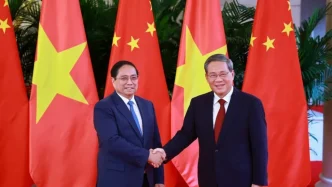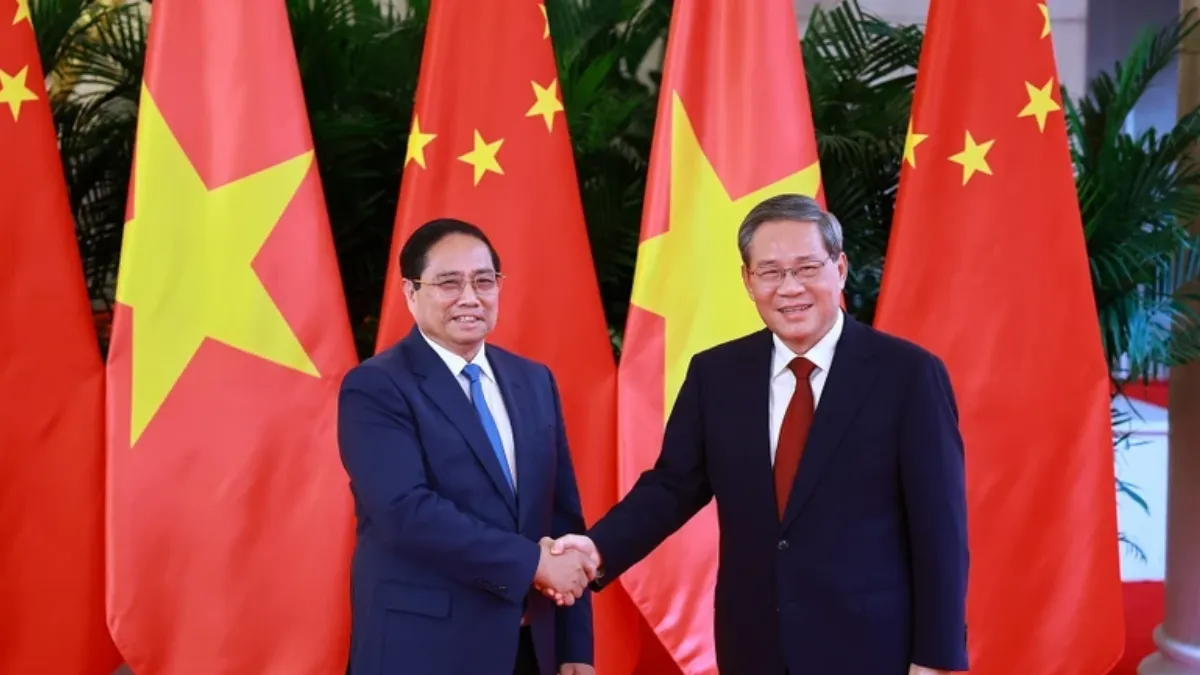At a high-profile business forum in Tianjin, China, on June 24, 2025, Vietnamese Prime Minister Phạm Minh Chính underscored the deepening economic partnership between Vietnam and China, signaling a new chapter of collaboration in trade, investment, and innovation. Speaking at the Vietnam–China Business Connection Forum, held alongside the 16th Annual Meeting of the New Champions of the World Economic Forum, the Prime Minister called for practical, mutually beneficial cooperation amid a backdrop of global uncertainties.
A Strategic Partnership Anchored in Economics
The forum, themed around cooperation in infrastructure, modern financial services, and green energy-driven production, drew a significant crowd of government officials, diplomats, and business leaders from both nations. Prime Minister Chính, accompanied by Deputy Prime Minister and Foreign Minister Bùi Thanh Sơn, as well as several Vietnamese ministers and provincial leaders, emphasized that economic ties remain a cornerstone of the Vietnam–China relationship. “The space and potential for economic cooperation between our two countries remain vast, especially in science, technology, innovation, digital and green transformation, and the circular economy” he said.
This sentiment reflects a broader strategic vision shared by the top leadership of both countries, who have committed to building a “Vietnam–China Community with a Shared Future.” This framework, grounded in six guiding principles, prioritizes deeper and more substantive cooperation. For Prime Minister Chính, businesses are pivotal in translating political trust into tangible economic outcomes, acting as bridges between the two economies. He urged companies to pursue “win-win partnerships” that balance shared interests and risks, particularly in high-tech sectors, energy, infrastructure, and financial services.
Robust Trade and Investment Growth
The economic relationship between Vietnam and China has seen remarkable growth in recent years, positioning the two nations as critical partners in the region. In 2024, bilateral trade reached an impressive US$205.2 billion, marking a 19.3 percent increase year-on-year. This made Vietnam China’s largest trading partner within ASEAN and the fourth-largest globally. The momentum has continued into 2025, with two-way trade for the first five months amounting to US$92.9 billion, up 18.7 percent compared to the same period in 2024.
China also stands as a major investor in Vietnam, ranking sixth among 148 countries and territories with foreign direct investment (FDI) in the country. By the end of 2024, Chinese investors had initiated 5,111 projects with a total registered capital of US$30.83 billion. These investments span 19 of Vietnam’s 21 FDI sectors and are present in 55 of its 63 provinces and cities. From manufacturing to real estate, Chinese capital has played a significant role in shaping Vietnam’s economic landscape.
Beyond trade and investment, tourism has emerged as another vital link. In 2024, Vietnam welcomed 3.74 million Chinese visitors, accounting for over 21 percent of its international arrivals. This figure positioned China as the second-largest source market for Vietnam’s tourism industry, a sector that has rebounded strongly post-pandemic and continues to bolster cultural and economic exchanges between the two nations.
Business Sentiment and Opportunities
During the Tianjin forum, Chinese business representatives expressed optimism about Vietnam’s economic trajectory, describing it as one of the region’s fastest-growing and most dynamic markets. They highlighted Vietnam’s improving investment climate, characterized by government reforms, a young and skilled workforce, and strategic geographic positioning. Many expressed a keen interest in expanding operations, particularly in infrastructure development, high technology, and clean energy—sectors aligned with global sustainability goals.
Vietnamese businesses, on the other hand, articulated the country’s ambitious development objectives, which include digital transformation, innovation, and major infrastructure upgrades. Key areas of focus include railway transport and telecommunications, where they hope to leverage Chinese expertise and financing. Representatives called for continued support through technology transfer and smart governance solutions, seeing these as critical to Vietnam’s modernization efforts.
Prime Minister Chính echoed this forward-looking perspective, praising China’s rapid advancements in science, technology, and infrastructure. “Vietnam is now entering a new era of prosperity and modernization” he said, pointing to the country’s pursuit of breakthroughs in institutional reforms, infrastructure development, and human resource capacity to enhance productivity and competitiveness.
Historical Ties and Global Challenges
The Prime Minister also reflected on the deep historical and cultural connections between Vietnam and China, noting their shared revolutionary roots and long-standing cooperation. These ties, he argued, provide a strong foundation for navigating contemporary global challenges. “The world today presents more challenges than opportunities. That is why Vietnam and China, and our businesses, must unite and remain confident, ready to turn difficulties into drivers of growth” he said.
Indeed, the geopolitical landscape in 2025 remains fraught with uncertainties—from trade tensions to regional security concerns. Against this backdrop, the Vietnam–China partnership offers a stabilizing force in Southeast Asia. The forum in Tianjin served as a reminder of the potential for economic collaboration to transcend political divides, fostering mutual prosperity even as global headwinds intensify.
The event also marked a concrete step forward, with nine cooperation agreements signed between Vietnamese and Chinese entities. These agreements covered diverse fields such as energy, railway infrastructure, information technology, telecommunications, real estate, transportation, and the import and export of goods. While specifics of the deals were not disclosed, they signal a deepening of practical collaboration at the enterprise level, aligning with the strategic directives outlined by both governments.
Learning from China’s Development Model
A notable theme in Prime Minister Chính’s address was Vietnam’s eagerness to learn from China’s development experience. Over the past few decades, China has transformed into a global economic powerhouse through aggressive investments in infrastructure, technology, and innovation. Vietnam, which shares similar aspirations of rapid modernization, sees China as a model for balancing economic growth with social stability.
This learning process is already evident in Vietnam’s policy priorities. The government has rolled out initiatives to enhance digital infrastructure, promote renewable energy, and streamline bureaucratic processes to attract foreign investment. Chinese expertise in high-speed rail, smart manufacturing, and green technologies could prove instrumental as Vietnam seeks to upgrade its transportation networks and industrial base.
However, this relationship is not without its complexities. While economic ties are strengthening, Vietnam remains cautious about over-reliance on any single partner, including China. Historical tensions and differing geopolitical interests occasionally cast a shadow over bilateral relations. For instance, maritime disputes in the South China Sea continue to be a point of contention, even as both sides strive to compartmentalize such issues and focus on economic cooperation.
Regional Implications of Closer Ties
The deepening economic partnership between Vietnam and China holds significant implications for the broader Southeast Asian region. As China’s largest trading partner in ASEAN, Vietnam serves as a gateway for Chinese goods and investments into the bloc. This relationship could help drive regional integration, particularly through initiatives like the Belt and Road Initiative, in which Vietnam plays a strategic role due to its proximity and connectivity.
At the same time, Vietnam’s growing economic clout enhances its standing within ASEAN, potentially positioning it as a counterbalance to China’s influence. Analysts suggest that Hanoi’s strategy involves leveraging partnerships with multiple powers—including the United States, Japan, and the European Union—to diversify its economic dependencies while maximizing benefits from its relationship with Beijing.
For Chinese businesses, Vietnam offers a stable and cost-effective manufacturing hub, especially as global supply chains shift in response to trade policies and labor costs. The success of Chinese enterprises in Vietnam, as Prime Minister Chính noted, contributes directly to the country’s development, creating jobs and fostering technology transfer. Yet, it also raises questions about local capacity building and ensuring that Vietnamese firms are not sidelined in this dynamic.
Looking Ahead: Challenges and Opportunities
As Vietnam and China chart a path of closer economic integration, several challenges loom on the horizon. Ensuring equitable benefits from trade and investment will be critical, particularly for Vietnam, which seeks to avoid trade imbalances that have historically favored China. Strengthening domestic industries and fostering innovation at home will be essential to maintaining a balanced partnership.
Moreover, both nations must navigate the complexities of global economic trends, including the push for decarbonization and digitalization. Collaboration in green energy and smart manufacturing, as highlighted at the Tianjin forum, could position them as leaders in sustainable development within the region. Yet, achieving these goals will require overcoming hurdles such as technological gaps and financing constraints.
For now, the momentum in Vietnam–China relations appears strong, buoyed by political goodwill and a shared commitment to economic progress. The agreements signed at the forum are a testament to the practical steps being taken to translate high-level rhetoric into on-the-ground results. As Prime Minister Chính concluded, the success of this partnership will hinge on the ability of businesses to drive forward cooperation, creating value for both nations amid an uncertain global landscape.
As the two countries build on this foundation, the question remains: can Vietnam and China sustain this trajectory of growth while addressing the geopolitical and economic challenges that lie ahead? The answer, for now, lies in the hands of policymakers and entrepreneurs alike, whose joint efforts will shape the future of this critical relationship.















